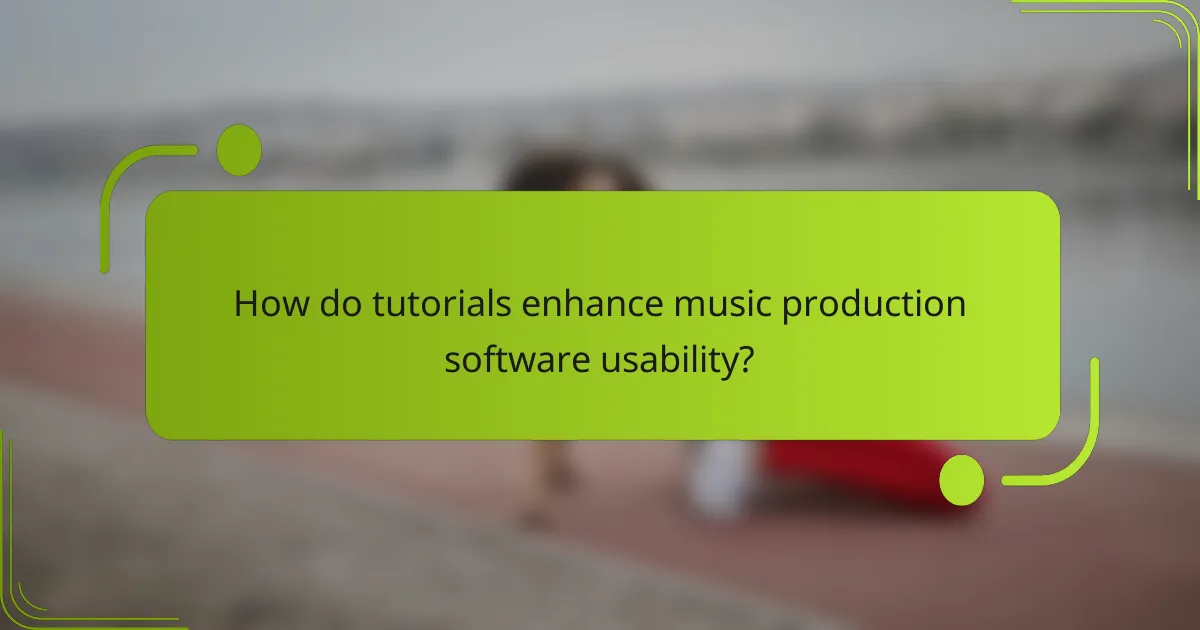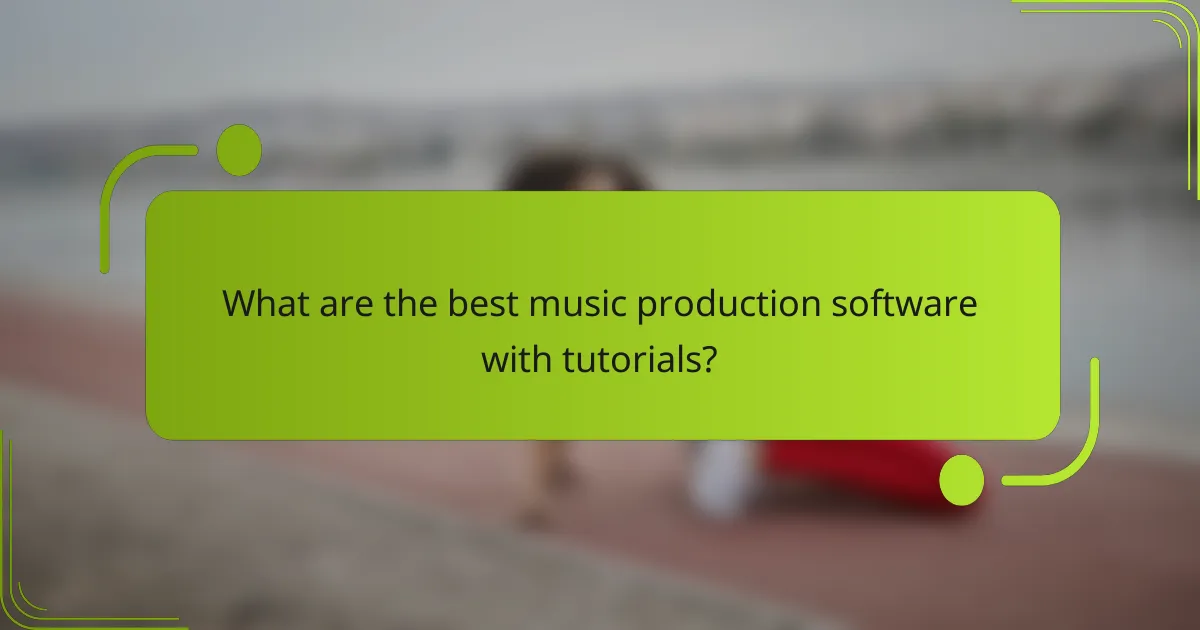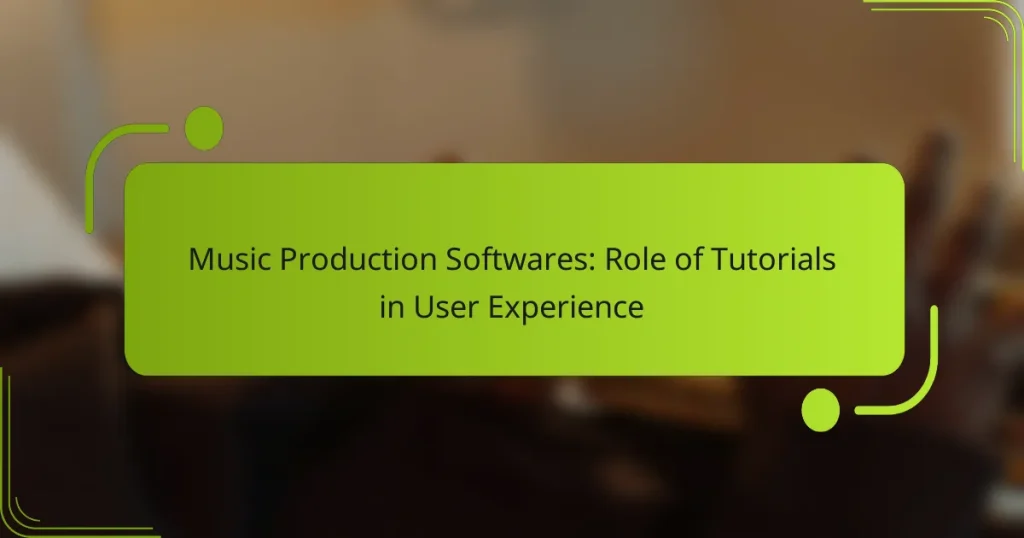Tutorials play a crucial role in enhancing the user experience of music production software by offering structured guidance and practical insights. They simplify complex features, allowing users to navigate the software more effectively and unlock its full potential. With platforms like Ableton Live, FL Studio, and Logic Pro X providing comprehensive learning resources, both beginners and experienced producers can significantly improve their skills.

How do tutorials enhance music production software usability?
Tutorials significantly enhance the usability of music production software by providing users with structured guidance and practical insights. They help demystify complex features, making it easier for users to navigate the software and maximize its potential.
Improved user onboarding
Effective tutorials streamline the onboarding process for new users by introducing them to essential functions and workflows. For instance, video walkthroughs or interactive guides can help users quickly understand how to set up their projects, manage audio tracks, and apply effects.
By offering step-by-step instructions, tutorials reduce the initial learning curve, allowing users to start producing music sooner. This early engagement can lead to increased satisfaction and retention rates among new users.
Increased software proficiency
Tutorials contribute to greater proficiency in music production software by covering advanced techniques and features. Users can learn about sound design, mixing, and mastering through comprehensive lessons that build on their foundational knowledge.
Regularly engaging with tutorials can help users develop a deeper understanding of the software’s capabilities, enabling them to create more polished and professional-sounding tracks. This ongoing learning process is crucial for anyone looking to enhance their skills in music production.
Enhanced creative exploration
With tutorials, users are encouraged to experiment with different styles and techniques, fostering creative exploration. By showcasing various production methods, tutorials can inspire users to try new approaches and push their artistic boundaries.
For example, a tutorial on using specific plugins or sound libraries can open up new sonic possibilities, allowing users to incorporate unique elements into their music. This exploration not only enriches their creative output but also helps them develop a distinctive sound over time.

What are the best music production software with tutorials?
Some of the best music production software that includes tutorials are Ableton Live, FL Studio, and Logic Pro X. These platforms offer comprehensive learning resources that enhance user experience and facilitate skill development for both beginners and experienced producers.
Ableton Live
Ableton Live is renowned for its intuitive interface and powerful features, making it a favorite among electronic music producers. The software provides a variety of built-in tutorials that guide users through its functionalities, from basic beat-making to advanced sound design.
To get the most out of Ableton Live, take advantage of its session view for live performances and its arrangement view for traditional recording. Users should explore the extensive library of samples and instruments available, which can significantly enhance creativity.
FL Studio
FL Studio is popular for its user-friendly design and robust capabilities, especially for hip-hop and electronic genres. The software includes a wealth of tutorials that cover everything from the basics of the interface to complex mixing techniques.
When using FL Studio, familiarize yourself with the piano roll for composing melodies and the mixer for audio effects. New users should avoid overwhelming themselves by starting with simple projects and gradually incorporating more advanced features as they gain confidence.
Logic Pro X
Logic Pro X is a comprehensive digital audio workstation favored by macOS users for its professional-grade tools and extensive library of sounds. The software offers a range of tutorials that help users navigate its advanced features, such as MIDI editing and audio recording.
For optimal use of Logic Pro X, take time to explore its Smart Controls and Flex Time features, which can streamline the production process. Beginners should focus on mastering the basics before diving into more intricate aspects like automation and plugin management.

How can users find quality tutorials for music production software?
Users can find quality tutorials for music production software through various platforms that cater to different learning styles and preferences. Popular options include YouTube channels, online courses on platforms like Udemy, and the official websites of the software providers themselves.
YouTube channels
YouTube is a rich resource for music production tutorials, offering a wide range of content from beginner to advanced levels. Channels like Point Blank Music School, ADSR Music Production Tutorials, and Andrew Huang provide valuable insights and practical demonstrations.
When searching for tutorials, look for channels with high subscriber counts and positive engagement in the comments section. This often indicates quality content and a supportive community.
Online courses on Udemy
Udemy features numerous structured courses on music production software, often created by industry professionals. These courses typically include video lectures, downloadable resources, and assignments to reinforce learning.
Prices for Udemy courses can range from affordable to premium, often with discounts available. Check user ratings and reviews to ensure the course meets your needs before enrolling.
Official software websites
Many music production software companies provide tutorials directly on their official websites. These resources often include user manuals, video tutorials, and community forums for troubleshooting.
Utilizing official tutorials ensures that you are learning the most accurate and up-to-date information about the software. Look for sections labeled “Support” or “Resources” on the software’s website to access these materials easily.

What are the key features of effective music production tutorials?
Effective music production tutorials should provide clear, structured guidance that enhances the user experience. Key features include step-by-step instructions, interactive elements, and real-world examples that help users grasp complex concepts and apply them practically.
Step-by-step guidance
Step-by-step guidance is crucial for beginners navigating music production software. This approach breaks down processes into manageable tasks, allowing users to follow along without feeling overwhelmed. For instance, a tutorial might start with setting up a digital audio workstation (DAW) and progress through recording, editing, and mixing.
Effective tutorials often use numbered lists or bullet points to outline each step clearly. This format helps users track their progress and ensures they don’t miss essential actions, such as adjusting audio levels or applying effects.
Interactive elements
Incorporating interactive elements, such as quizzes or hands-on exercises, significantly enhances the learning experience. These features encourage users to engage actively with the material, reinforcing their understanding of music production concepts. For example, a tutorial might include a mini-project where users create a simple track using provided samples.
Interactive elements can also include video demonstrations where users can pause and practice alongside the tutorial. This real-time application helps solidify skills and builds confidence in using the software.
Real-world examples
Real-world examples illustrate how music production techniques are applied in actual projects, making the learning process more relatable. Tutorials that showcase popular songs or industry-standard practices help users understand the relevance of what they are learning. For instance, analyzing a hit track’s mixing techniques can provide insight into professional workflows.
Additionally, including case studies or interviews with experienced producers can offer valuable tips and tricks. These insights can inspire users and provide practical advice that goes beyond theoretical knowledge, helping them to develop their unique sound.

How do user experiences differ across music production software?
User experiences in music production software can vary significantly based on factors like interface complexity, feature accessibility, and community support. These elements influence how easily users can create, edit, and produce music, affecting their overall satisfaction and productivity.
Interface complexity
The complexity of a software interface can greatly impact user experience. Software with a cluttered or unintuitive layout may overwhelm beginners, while streamlined interfaces often enhance usability. For instance, programs like Ableton Live offer a more straightforward design, making it easier for new users to navigate compared to more intricate options like Pro Tools.
When choosing software, consider your skill level and the learning curve associated with the interface. A simpler interface may allow for quicker mastery, while a complex one might offer advanced features that could be beneficial in the long run.
Feature accessibility
Feature accessibility refers to how easily users can find and utilize the tools they need within the software. Some programs may bury essential features under multiple menus, while others provide quick access through customizable toolbars. For example, FL Studio is known for its accessible features, allowing users to quickly drag and drop samples, whereas Logic Pro may require more navigation to access similar tools.
To enhance your experience, familiarize yourself with the software’s layout and consider using tutorials to discover shortcuts and hidden features. This can save time and improve your workflow significantly.
Community support
A strong community can enhance the user experience by providing resources, tutorials, and forums for troubleshooting. Software with an active user base, like GarageBand, often has a wealth of online tutorials and user-generated content that can help beginners learn quickly. In contrast, less popular software may lack this support, making it harder for users to find help when needed.
Engaging with community forums and social media groups can provide valuable insights and tips. Look for platforms that offer extensive user support, as this can greatly improve your learning curve and overall satisfaction with the software.

What role do community forums play in music production tutorials?
Community forums are essential for enhancing music production tutorials by providing a platform for interaction, feedback, and shared learning experiences. They allow users to ask questions, share insights, and collaborate, making the learning process more dynamic and effective.
Peer support
Peer support in community forums fosters a collaborative environment where users can seek help and encouragement from fellow music producers. This support can take the form of advice on software usage, troubleshooting issues, or sharing personal experiences that can guide others in their production journey.
For example, a beginner struggling with a specific digital audio workstation (DAW) can post questions and receive answers from more experienced users, often leading to quicker problem resolution and increased confidence in their skills.
Resource sharing
Resource sharing is a key feature of community forums, where users can exchange valuable materials such as tutorials, sample packs, and plugins. This sharing not only enriches the learning experience but also helps users discover new tools and techniques that can enhance their music production.
For instance, a user might share a link to a free plugin or a video tutorial that simplifies a complex production technique, enabling others to improve their workflow without incurring additional costs. Engaging in these exchanges can significantly broaden a user’s knowledge base and practical skills in music production.


